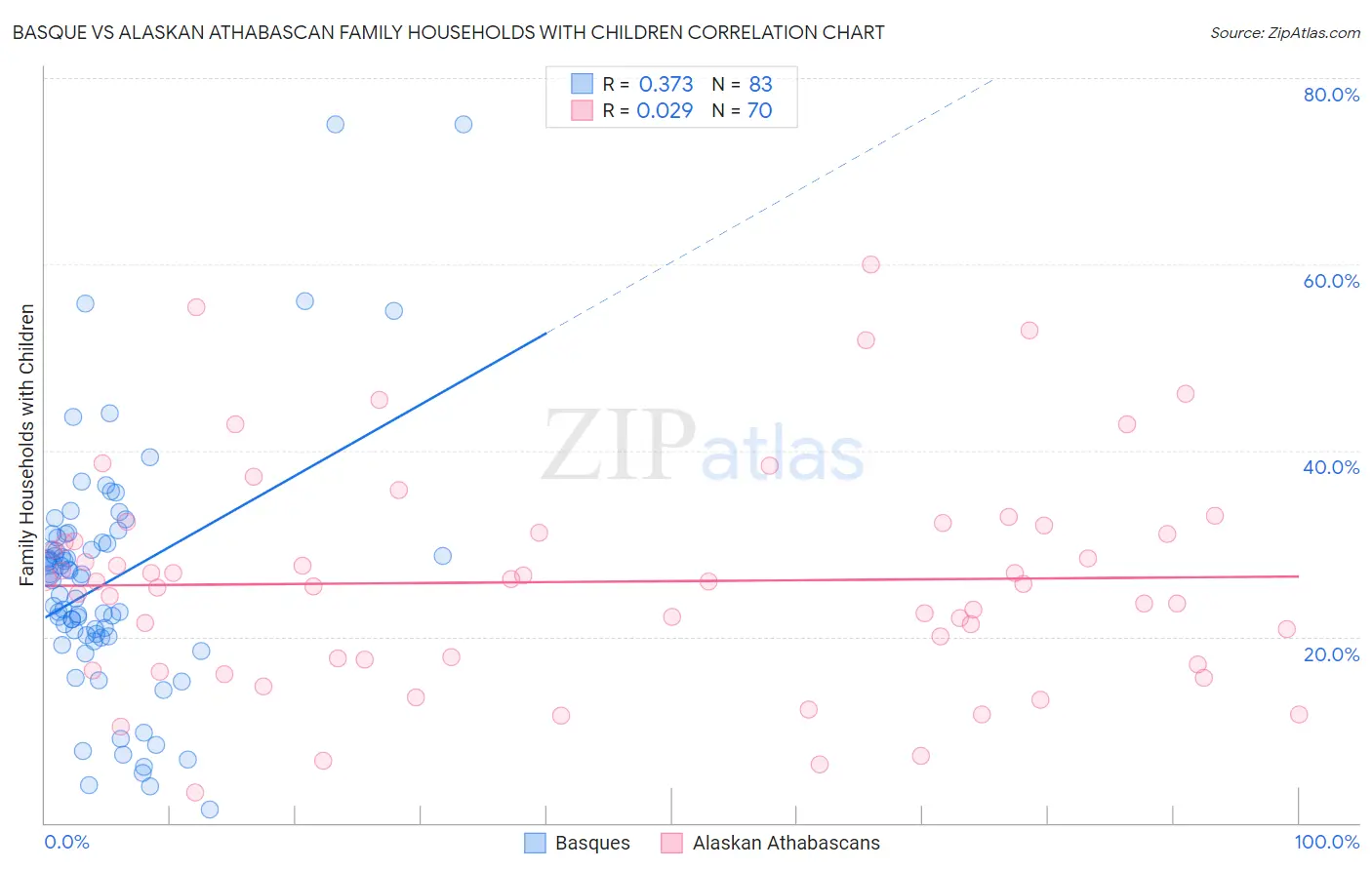Basque vs Alaskan Athabascan Family Households with Children
COMPARE
Basque
Alaskan Athabascan
Family Households with Children
Family Households with Children Comparison
Basques
Alaskan Athabascans
27.7%
FAMILY HOUSEHOLDS WITH CHILDREN
79.5/ 100
METRIC RATING
146th/ 347
METRIC RANK
27.6%
FAMILY HOUSEHOLDS WITH CHILDREN
67.1/ 100
METRIC RATING
161st/ 347
METRIC RANK
Basque vs Alaskan Athabascan Family Households with Children Correlation Chart
The statistical analysis conducted on geographies consisting of 165,699,592 people shows a mild positive correlation between the proportion of Basques and percentage of family households with children in the United States with a correlation coefficient (R) of 0.373 and weighted average of 27.7%. Similarly, the statistical analysis conducted on geographies consisting of 45,814,006 people shows no correlation between the proportion of Alaskan Athabascans and percentage of family households with children in the United States with a correlation coefficient (R) of 0.029 and weighted average of 27.6%, a difference of 0.35%.

Family Households with Children Correlation Summary
| Measurement | Basque | Alaskan Athabascan |
| Minimum | 1.5% | 3.3% |
| Maximum | 75.0% | 60.0% |
| Range | 73.5% | 56.7% |
| Mean | 26.0% | 25.9% |
| Median | 26.3% | 25.8% |
| Interquartile 25% (IQ1) | 20.0% | 17.5% |
| Interquartile 75% (IQ3) | 30.6% | 31.1% |
| Interquartile Range (IQR) | 10.6% | 13.6% |
| Standard Deviation (Sample) | 13.3% | 11.8% |
| Standard Deviation (Population) | 13.2% | 11.7% |
Demographics Similar to Basques and Alaskan Athabascans by Family Households with Children
In terms of family households with children, the demographic groups most similar to Basques are Immigrants from Chile (27.7%, a difference of 0.0%), Brazilian (27.7%, a difference of 0.010%), Immigrants from Moldova (27.6%, a difference of 0.010%), Osage (27.6%, a difference of 0.020%), and Menominee (27.6%, a difference of 0.020%). Similarly, the demographic groups most similar to Alaskan Athabascans are Immigrants from Bangladesh (27.6%, a difference of 0.0%), Subsaharan African (27.6%, a difference of 0.010%), Czech (27.5%, a difference of 0.040%), Romanian (27.6%, a difference of 0.090%), and Mongolian (27.6%, a difference of 0.090%).
| Demographics | Rating | Rank | Family Households with Children |
| Immigrants | Eastern Africa | 80.2 /100 | #143 | Excellent 27.7% |
| Brazilians | 79.6 /100 | #144 | Good 27.7% |
| Immigrants | Chile | 79.5 /100 | #145 | Good 27.7% |
| Basques | 79.5 /100 | #146 | Good 27.7% |
| Immigrants | Moldova | 79.1 /100 | #147 | Good 27.6% |
| Osage | 79.0 /100 | #148 | Good 27.6% |
| Menominee | 78.9 /100 | #149 | Good 27.6% |
| Argentineans | 78.5 /100 | #150 | Good 27.6% |
| Portuguese | 77.8 /100 | #151 | Good 27.6% |
| Ethiopians | 77.0 /100 | #152 | Good 27.6% |
| Immigrants | Cabo Verde | 75.6 /100 | #153 | Good 27.6% |
| Icelanders | 75.3 /100 | #154 | Good 27.6% |
| Comanche | 74.8 /100 | #155 | Good 27.6% |
| Hungarians | 74.6 /100 | #156 | Good 27.6% |
| Indians (Asian) | 71.6 /100 | #157 | Good 27.6% |
| Romanians | 70.8 /100 | #158 | Good 27.6% |
| Mongolians | 70.7 /100 | #159 | Good 27.6% |
| Sub-Saharan Africans | 67.5 /100 | #160 | Good 27.6% |
| Alaskan Athabascans | 67.1 /100 | #161 | Good 27.6% |
| Immigrants | Bangladesh | 67.0 /100 | #162 | Good 27.6% |
| Czechs | 65.3 /100 | #163 | Good 27.5% |